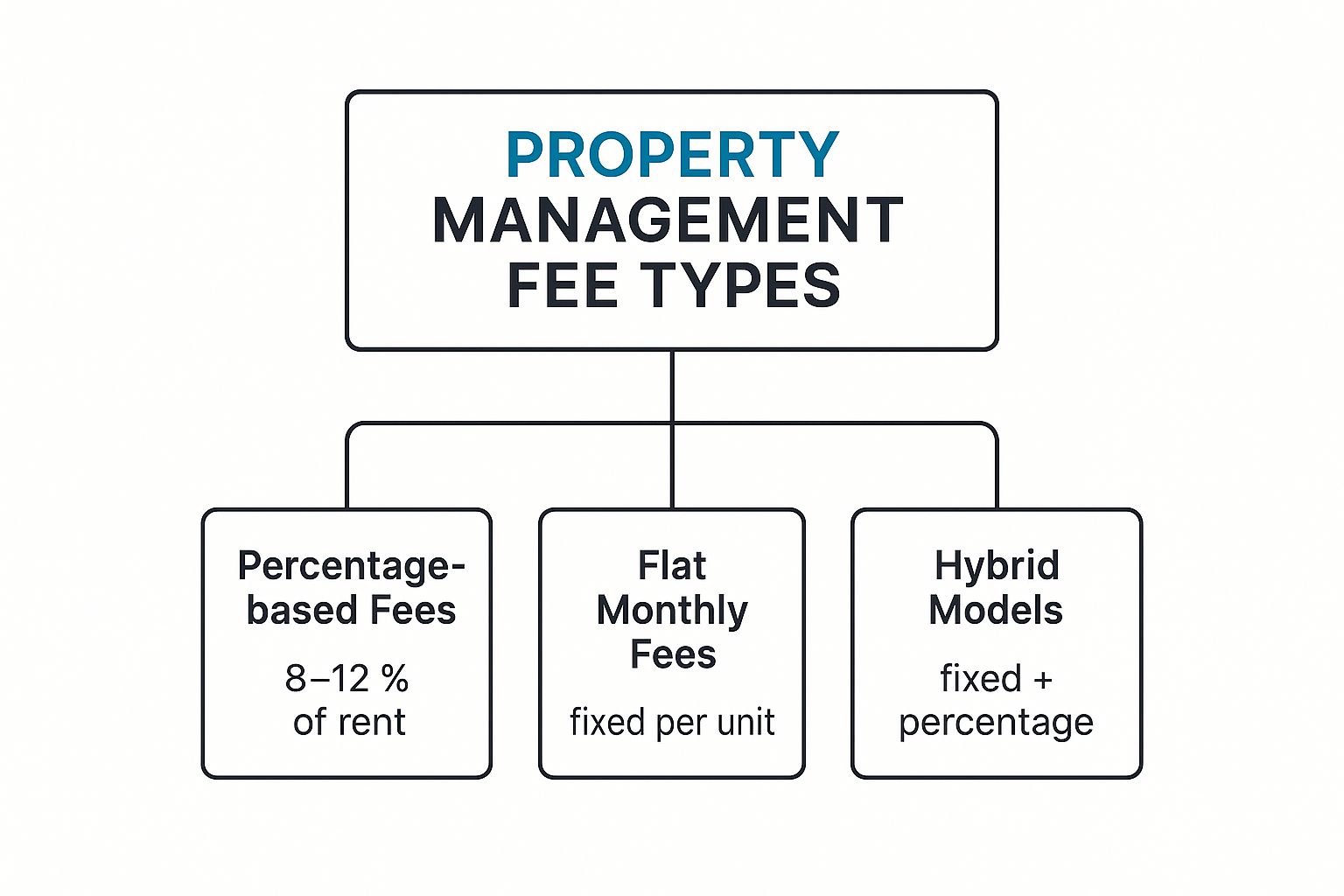For a large-scale property management company, a management fee isn't just an expense—it's a critical investment in operational efficiency and portfolio performance. It's the cost of outsourcing the complex logistics of managing hundreds or thousands of rental units, from tenant screening and rent collection to maintenance coordination and financial reporting. A strategic approach to this fee directly impacts key performance indicators (KPIs) like Days on Market (DOM) and cost per door.
What Your Management Fee Actually Buys: An Operational Framework

Your property manager serves as the outsourced Chief Operating Officer for your assets. Your fee fuels this operational engine, enabling your core team to focus on portfolio strategy and growth while they manage the day-to-day execution. For companies managing distributed portfolios, this partnership is essential for scalable, sustainable expansion.
Crucially, you aren't just paying for a list of services; you're investing in a system—a proven, repeatable process ensuring every property is managed with consistent quality and efficiency. This is vital for standardizing operations across multi-market portfolios.
Standard Services Covered by Your Management Fee
While agreements vary, most management fees bundle the core operational tasks required to maintain asset value and profitability. These services are the foundation of a high-performing remote property management operation.
Here's a breakdown of the typical services you can expect:
This systematic approach is why the global property management market is projected to grow significantly. The market, valued at USD 23.94 billion in 2025, is expected to grow at a compound annual rate of 7.1% through 2033, a clear indicator that large-scale owners see the ROI in outsourcing for optimized performance. You can dig deeper into the property management market growth and trends to see where the industry is headed.
In essence, your management fee buys operational leverage. It allows your core team to shift focus from reactive, unit-level tasks to proactive, strategic initiatives that drive portfolio growth and increase revenue.
Understanding the direct link between your management fee and these operational cornerstones allows for a more effective evaluation of potential partners. The goal is to maximize the return on your management investment, which is the key to unlocking true scalability.
Choosing Your Fee Structure for Maximum Portfolio ROI
Structuring your management fee is a strategic decision that defines the partnership with your property manager and directly impacts your bottom line. For operators managing portfolios of single-family rentals and multifamily units without onsite staff, getting this right is crucial for scaling efficiently. The objective is to create a win-win scenario where your manager’s incentives are directly aligned with your portfolio's financial performance.
For most large portfolios, the choice comes down to three models: percentage-based, flat-fee, or a hybrid structure. Each has distinct implications for aggressive growth strategies versus predictable budgeting.
The Percentage-Based Model
The percentage-based model is the industry standard for a clear reason: it aligns incentives. Your manager earns a percentage of the monthly rent collected—typically between 8% and 12% for smaller portfolios, but often lower for enterprise clients. This structure gives them a powerful, built-in motivation to maximize your revenue.
This alignment pushes managers to:
- Minimize Vacancy: Every day a unit sits empty, it impacts both your revenue and their fee. This shared financial pain is a powerful motivator for reducing Days on Market (DOM).
- Optimize Rental Rates: They are inherently driven to secure the highest possible market rent, as it directly increases their compensation.
- Prioritize Tenant Retention: High turnover erodes profitability for everyone, making tenant retention a shared financial goal.
For a growth-oriented portfolio, this alignment can transform your property manager into a true partner in driving revenue.
This visual breaks down the most common fee types you'll encounter.

As you can see, each model strikes a different balance between risk and reward for property owners.
The Flat-Fee Model
The flat-fee model offers one primary advantage: predictability. You pay a fixed dollar amount per unit each month, regardless of rental income or occupancy. For an operations director managing hundreds or thousands of units, this simplifies budgeting and financial forecasting significantly.
With a flat-fee structure, you eliminate variability in management expenses. This makes it incredibly easy to calculate your cost per door and maintain consistent operating margins across your entire portfolio.
This model is particularly effective for portfolios of similar properties or in markets with stable rental rates. The potential downside is a misalignment of incentives. Since the manager's fee isn't tied to occupancy or rent levels, there's less inherent motivation to fill vacancies rapidly or negotiate for top-market rent.
The Hybrid Model
A hybrid model combines the benefits of both structures. It typically involves a lower flat fee paired with a performance-based incentive, such as a smaller percentage of collected rent or a bonus for achieving specific KPIs (e.g., maintaining occupancy above 95%). This approach provides the manager with a stable revenue base while still incentivizing them to meet key performance targets.
This balanced structure offers budgetary control while motivating your manager to enhance revenue, making it an attractive option for many large-scale operators.
Ultimately, the optimal choice depends on your portfolio's specific characteristics and strategic objectives. To dig a little deeper, check out these 8 ways to boost ROI for your properties by aligning your fee structure with your financial goals.
How to Accurately Calculate Management Costs Across Your Portfolio

Moving from theory to practice, accurately calculating your management expenses is critical for maintaining portfolio profitability. An error in forecasting can erode your net operating income (NOI), especially when managing hundreds or thousands of doors. The key is to understand the precise mechanics of each fee structure.
For the percentage-based model, the calculation seems simple, but a critical detail in the contract language can have a significant financial impact.
The basic formula is:
Monthly Rent x Fee Percentage = Monthly Fee
The pivotal question is how "rent" is defined. Is the fee based on rent collected or rent due? This distinction can dramatically affect your bottom line.
Rent Collected vs. Rent Due: A Critical Distinction for Large Portfolios
A fee based on rent collected is the industry best practice. It means your property manager is only paid when you are. If a unit is vacant or a tenant defaults, your manager shares in the financial loss. This creates a powerful incentive to maintain high occupancy and pursue collections diligently.
Conversely, a fee based on rent due means the manager receives their fee even if the unit is vacant. This can create a significant cash flow drain, particularly during lease-ups or periods of higher-than-expected vacancy. You end up paying for management on a non-performing asset.
Let's analyze the financial impact on a 500-unit portfolio with an average rent of $2,000 and a 7% management fee.
- Rent Collected Model (at 95% occupancy): 475 units x $2,000 x 7% = $66,500 monthly fee
- Rent Due Model (at 95% occupancy): 500 units x $2,000 x 7% = $70,000 monthly fee
That's a $3,500 difference in a single month. Annually, that small contractual detail could cost your portfolio $42,000.
Forecasting Flat-Fee Expenses at Scale
The flat-fee model offers directness and predictability, making it a preferred choice for operations teams focused on consistent cost-per-door metrics.
The calculation is straightforward:
Flat Fee Per Unit x Total Number of Units = Total Monthly Management Cost
For a 1,200-unit portfolio with a negotiated $100 per door flat fee:
- 1,200 units x $100/unit = $120,000 in predictable monthly management costs.
This clarity allows for precise financial modeling and enables an apples-to-apples comparison of management proposals. Mastering these calculations empowers your team to make data-driven decisions that protect your NOI and support scalable growth.
Key Factors That Drive Your Management Fee Rate
There is no universal rate for a management fee property; the cost is a direct reflection of the complexity, risk, and operational effort your portfolio requires. Several key variables influence the final percentage or flat fee.
For large-scale operators, understanding these drivers is crucial. It transforms the negotiation from a simple price discussion into a strategic conversation about value and operational partnership. Knowing what influences the cost ensures you pay a fair rate for the specific services your portfolio needs.
Property Type and Portfolio Composition
The makeup of your portfolio is a primary factor. Managing 500 scattered single-family homes presents different logistical challenges than overseeing a single 500-unit apartment building without onsite staff.
- Single-Family Rentals (SFRs): These often require significant travel time between properties for showings, inspections, and maintenance, increasing the operational cost per door for remote management.
- Multifamily Properties: While centralized, these can demand more intensive tenant relations, amenity management, and coordination, altering the scope of work.
An effective manager must assess the logistical reality of your asset mix. A dense portfolio of similar buildings is operationally simpler to manage than a geographically dispersed collection of varied property types, and the fee will reflect that complexity.
Geographic Location and Market Dynamics
The location of your properties is a significant cost driver. A portfolio in a high-cost urban center like San Francisco or New York will command a higher management fee than one in a lower-cost suburban market.
Market-specific factors include:
- Higher labor costs for maintenance technicians and leasing agents.
- Greater marketing expenses required to remain competitive.
- Complex local regulations that demand specialized legal and compliance expertise.
A property manager's overhead costs vary by location, and their pricing structure must align with these local economic realities.
Scope of Services and Economies of Scale
The scope of services is perhaps the most significant factor. A basic rent collection agreement will be considerably less expensive than a full-service contract covering leasing, maintenance, financial reporting, and legal compliance.
For large-scale operators, portfolio size is your greatest negotiating asset. Entrusting a manager with 1,000 units versus 10 creates powerful economies of scale. This principle mirrors large investment funds, where core funds with over $1 billion in assets under management typically have lower expense ratios. The fixed costs are distributed across a massive asset base, driving down the per-unit cost. You can learn more about how management fees and terms work in large-scale funds to see this principle in action.
By leveraging your portfolio's scale, you can negotiate a lower per-door management fee. You are not just another client; you are a strategic partner offering significant, stable revenue, which justifies a more favorable rate.
Uncovering Additional and Potentially Hidden Fees
While the monthly management fee is the headline number, savvy operators know the full cost story is often found in the ancillary fees. These additional charges can significantly impact your net operating income (NOI) if not properly understood and accounted for.
A transparent property management partner will outline every potential charge upfront, ensuring there are no surprises on your monthly statements. These fees are standard practice, but clarity is non-negotiable for effective financial planning.
Common Additional Property Management Fees
Think of the monthly fee as covering routine operations. Ancillary fees typically arise from specific, resource-intensive events that fall outside of day-to-day oversight.
Here is a breakdown of the most common fees to anticipate in a management agreement:
While this list covers the primary fees, always review your agreement for other potential charges, such as periodic inspection fees or project management fees for large capital improvements.
Digging Into Your Management Agreement
Thoroughly review every line of your management contract. Seek clear definitions for what triggers each fee and how it is calculated. This is your opportunity to ask questions and negotiate. As a large-portfolio client, you have leverage to request caps on certain fees or waive others entirely.
Proper documentation is also your best defense against future disputes. Understanding the importance of property condition reports is crucial for creating an indisputable record of a unit's condition, which can save thousands in security deposit disputes.
Key Takeaway: Your management agreement is your primary tool for cost control. Scrutinize every line item, clarify ambiguities, and ensure you are comfortable with the entire fee structure before signing.
By treating these additional charges with the same diligence as the base management fee, you can build a transparent and predictable partnership, allowing you to focus on strategic portfolio growth.
The True ROI of Your Management Fee: A Performance-Based Perspective
It's time to reframe the property management fee from a simple operating expense to a strategic investment in portfolio performance. The right management partner doesn't just collect rent; they directly impact the KPIs that drive profitability, such as Days on Market (DOM) and tenant retention.
An effective manager implements systems to reduce vacancy, streamline operations, and provide the efficiency needed to scale profitably. This is critical in the U.S. residential property management sector, which employs approximately 720,000 people and is projected to reach a market size of $98.88 billion by 2029. You can get more details on the property management market scale on doorloop.com.
It’s Not About Percentage Points—It’s About Performance
When evaluating management companies, the conversation must extend beyond the fee percentage. The critical question is, "How will this partner improve my portfolio's performance?" Their true value is measured by their ability to reduce vacancy loss and optimize operational efficiency. A well-run leasing operation that leverages tools like on-demand showing agents can significantly cut DOM, turning a potential expense into a revenue-generating investment.
Key Takeaway: A lower fee from an inefficient manager will cost you far more in vacancy loss than a higher fee from a partner who keeps your properties leased and operating at peak efficiency.
This data-driven approach allows you to make decisions that maximize the ROI of your management partnership. An effective manager acts as a growth engine, optimizing key metrics and reducing the high costs associated with tenant turnover.
A Few Common Questions
For large-scale operators, clarifying the details of a management agreement is essential for optimizing operational spend. Here are answers to common questions from portfolio managers and investors.
What’s a Typical Percentage for a Property Management Fee?
While the market standard for residential properties is typically 8% to 12% of collected monthly rent, this is not the benchmark for large portfolios. When managing 100+ units, you have significant negotiating leverage. It's common for enterprise-level clients to secure rates in the 5% to 7% range. This negotiation is a critical step in reducing your cost-per-door and improving overall portfolio profitability.
Are Property Management Fees Tax Deductible?
Yes, property management fees are considered a necessary operating expense for your rental business and are therefore tax-deductible. This deduction directly reduces your portfolio's taxable income, effectively lowering the net cost of management services. Always consult with a tax professional to ensure compliance and tailor advice to your specific financial situation.
Which Fee Structure Is Better for a Large Portfolio?
The optimal fee structure depends on your portfolio's characteristics and strategic goals.
- Percentage-Based Fee: This structure is excellent for aligning incentives. When your manager’s compensation is directly tied to rental income, they are motivated to minimize vacancy and maximize rents.
- Flat-Fee Model: This model provides unparalleled predictability, which is invaluable for budgeting and forecasting across hundreds or thousands of units. It simplifies cost-per-door calculations and ensures consistent expenses.
Many large-scale operators find a hybrid model offers the ideal balance. It combines the budget stability of a flat fee with performance-based incentives tied to KPIs like occupancy rates or DOM reduction, creating a partnership focused on both operational stability and revenue growth.
Ready to shrink your Days on Market and convert more leads into leases? Showdigs provides the leasing automation platform designed for property management at scale. Learn how to cut your vacancy time and boost your NOI.







